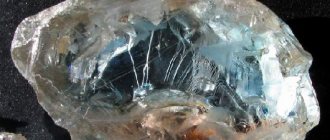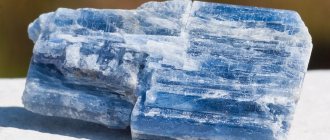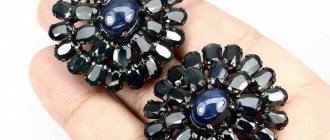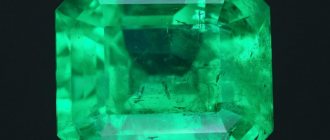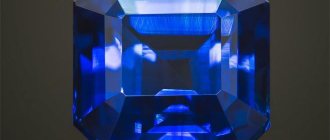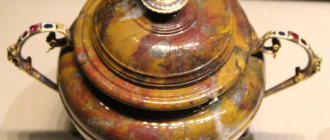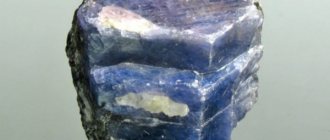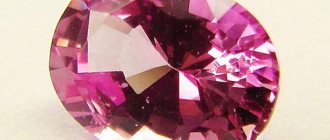Any precious and semi-precious stone is subject to high requirements, compliance with which determines the final cost of the stone and the jewelry adorned with it. Sapphires, one of the most expensive and beautiful minerals, are no exception. There are 4 generally accepted parameters by which the quality of sapphire can be determined.
Color
One of the main indicators of the quality of sapphires is the depth and richness of their shade. For blue stones, the reference shade is the shade of Kashmir corundum, pure cornflower blue. For fancy corundums, that is, those colored in colors other than red, there is no generally accepted standard.
To determine the color indicators of a mineral, professionals use special tables; the color is determined visually, without the use of instruments. This characteristic of sapphire has three components: tone, saturation and lightness. Interestingly, the last parameter is valued differently in different countries. Thus, dark corundums are more popular in Russia, while light corundums are more popular in Europe.
There are five categories of lightness and three of saturation; shades are usually divided according to the spectrum, but to simplify the classification in commerce, three names are used: bright (1), medium (2) and light (3) blue.
Healing properties
Raw sapphire Madagascar
People wearing a pendant inlaid with sapphire on their chest do not have to worry about the condition of the heart and blood vessels. The stone also has a positive effect on the endocrine system.
But not only does the blue crystal affect the heart and metabolism, it helps in the treatment of insomnia and mental disorders. In order for the gem to relieve sleep disturbances and nightmares, it should be placed under the pillow before bed.
But mainly the mineral affects the mental state of a person. It increases his intellectual abilities. Gives the owner a thirst for life, teaches him to cope with neuroses and depression.
And sapphire is the stone of those people who live long. It protects the owner from brain diseases, helps maintain clarity of mind until old age and live a long and happy life.
Modern medicine casts doubt on the ability of minerals to treat certain diseases, but the experience of our ancestors proves the opposite.
Jewelry inlaid with sapphires is chosen to last forever. They become a family heirloom and are passed on from generation to generation. Products such as good wine become more and more expensive every year.
Purity
The purity of sapphire is an important characteristic that affects the value and quality indicators of corundum. How to determine purity? First, it is determined by eye, and then a tenfold magnifying glass is used in order to study in more detail all the features of a particular specimen. The purity of a stone also means its transparency: these concepts are equivalent to each other. Below is a classification table that includes a description of the properties of stones, dividing them into four categories according to the level of purity and transparency.
| Category | Properties |
| 1 | Stones belonging to the first category have an almost perfect transparency. There are no serious defects inside, but there may be small inclusions that will only be noticeable upon detailed examination with a magnifying glass. Usually this doesn't matter much. The first category includes specimens of high value and purest color. |
| 2 | A sapphire stone of the second category can also be called transparent, but its color is more saturated, and the internal structure is characterized by the presence of defects and inclusions that are not visible under a magnifying glass. This means that the quality of sapphire of the 2nd category is not bad, but it may cost a little less than the stones of the first category. |
| 3 | Sapphire 3/3, or third category, is a completely opaque corundum, which has defects and inclusions inside, visible to the naked eye. You can also purchase this type of stone; as a rule, it’s not only a matter of price, but also of taste preferences, which can be different. |
| 4 | The characteristics of sapphire of the fourth category are low transparency, immediately noticeable defects, and uncertainty of color. Such stones can be quite cloudy, and their cost is much lower than that of representatives of the first two categories. |
When determining, it is important to consider that there is no other “scheme” that could be applied specifically to sapphire. Fraudsters or unprofessional sellers can sometimes use the IF category for advertising purposes and apply it to corundum, designating individual specimens as “a stone of perfect purity and transparency.” However, keep in mind that in reality, category IF, approved by one of the leading gemological institutes in the United States, has nothing to do with sapphires: “perfectly pure” corundum simply does not occur in the natural environment. Read about methods of refining sapphires here →
What does the concept of “sapphire quality” mean? This is a combination of color and purity indicators. Thus, a 3/3 sapphire (where the first number is color, the second is clarity) is of lower quality than a 1/1 stone.
How to choose a sapphire stone of decent quality? If you know about the four categories that determine its purity, you will have a much easier time completing this task. I would like to note right away that in some cases you may not need additional magnification. However, in order to choose the right sapphire, the characteristics of which will be the most worthy, you can carry a magnifying glass with you to exhibitions and sales of precious stones and use its help at any time.
Read also about diamond purity →
Artificial sapphire
The first synthetic sapphire was grown in the 19th century. Today, these stones are grown in special laboratories in about 30 days. They are grown using several methods:
- boiled. To weld sapphire, you need to take aluminum oxide - this is a white powder, add impurities, and heat it to the required temperature. In this case, it is extremely important to correctly maintain the proportions of the powder, because a more viscous material is responsible for the quality of the final product
- The most popular method is hydrothermal. In this method, seed plates are processed under pressure. To do this, the starting materials need to be heated to 300-5000°C. This method is quite complex, but it allows you to improve the color, transparency, and strength of nanosapphire. In addition, the hydrothermal method is quite expensive, therefore, the price of artificial sapphire will not be much lower than natural ones. Crystals are used to produce jewelry, watches and semiconductors.
Artificial stones have no color. To make them colorful, they are impregnated with dyes. Such impregnation is easily washed off; to avoid this, experts use the diffusion treatment method under high temperature conditions. Inclusions of iron and titanium are responsible for the color saturation. Beryllium is used to obtain yellow color. Artificial sapphires are very similar to natural minerals in physical, chemical, and optical composition. The crystals do not differ in structure either. During the sales process, unscrupulous sellers pass it off as synthetic sapphire. Despite the fact that they have nothing in common. Stones with synthetic inserts are cheap, their color is washed off with ordinary acetone, microcracks are filled with synthetic fillers and resins.
Cut
The cut of a sapphire and the method of processing the gemstone depend on its internal structure. As you know, there are different types of corundum, to which one or another cutting method can be applied.
In some cases, professional cutters use a method called cabochon:
- if the mineral belongs to the so-called star-shaped;
- if the sapphire has a large number of foreign inclusions or other defects that interfere with the classical cut.
In the first case, we are talking about the effect of asterism, when, after polishing, a star appears on the surface of a stone turned at a certain angle. In the case of sapphires, it will be 6- or 12-rayed. This effect is exhibited by varieties of minerals that contain needle-shaped rutile inclusions located at an angle to the surface. Asterism significantly increases the value of corundum.
Sapphires that do not have noticeable inclusions and are not capable of asterism are cut in the usual, faceted way: the stone can be given a round or oval shape, or made pear-shaped. Any colorless and seemingly unremarkable stone will become much more attractive after conventional processing.
Beware: doublets
online jewelry store
Gluing together minerals of different quality or natural sapphire and fakes is rare, but this method of simulating a more expensive stone is still quite possible. If the frame of the gem hides its bottom, then recognizing the doublet is very, very difficult. However, an ultraviolet lamp can come to the rescue here. After all, even if different parts of the stone do not glow differently or do not glow at all, the glue that connects them will certainly begin to fluoresce. Sapphire is the second hardest mineral after diamond. Therefore, its edges must be perfectly smooth. If you notice any chips or irregularities, it is unlikely that this is a real sapphire.
Carat
The weight of precious stones, including sapphires, is measured in carats. 1 carat is equal to 0.2 grams. But how can you understand how much a mineral in a piece of jewelry weighs if you can’t check it separately on a jewelry scale? You can measure its size.
Carat table for sapphires of the three most popular cuts:
| Round | Oval | Pear | |||
| mm | carats | mm | carats | mm | carats |
| 1 | 0,01 | 5×3 | 0,35 | 5×3 | 0,30 |
| 2 | 0,05 | 6×4 | 0,60 | 6×4 | 0,50 |
| 3 | 0,15 | 7×5 | 1,00 | 7×5 | 0,85 |
| 4 | 0,34 | 8×6 | 1,55 | 8×5 | 1,05 |
| 5 | 0,60 | 9×7 | 2,20 | 9×6 | 1,85 |
| 6 | 1,05 | 10×8 | 3,15 | 10×7 | 2,50 |
| 7 | 1,70 | 11×9 | 3,80 | ||
| 8 | 2,30 | 12×10 | 6,00 | ||
| 10 | 4,75 | ||||
If you are not purchasing jewelry from a trusted seller, and there is a suspicion that a sapphire that is too small in size weighs 2, 4, 6 carats, etc., as indicated on the tag, use a ruler and table.
Authentication by inclusions
online jewelry store
Natural sapphire must contain inclusions. But they should not be visible to the naked eye. Although this is not proof that the gem was obtained in laboratory conditions, it is a clear fact that this is a crystal of very poor quality.
It is best to examine stone inclusions using a magnifying glass. Although jewelers do this by immersing the crystal in a transparent container with monobromonaphthalene, which is placed on a white sheet of paper. But just a jar of water may do. The difference between artificial sapphire and natural one is that in natural stones all inclusions will be straight stripes. Whereas with synthetic ones, they are curved.
Origin
The above parameters are part of the four C rule, as it is called in Europe. But there is another, no less important indicator that determines the quality of corundum. This is its place of origin.
Despite the fact that sapphire deposits have been discovered on all continents, the purest and most attractive for the final owner are those from Kashmir, Ceylon, and Tanzania. The value of Kashmir is especially high, since this deposit is no longer being developed.
Burmese and Thai are considered to be of lower quality; stones from Australia have the lowest price on the market. In Russia, corundums are found in the Ural Mountains (often have a grayish tint) and on the Kola Peninsula (usually cornflower blue).
Where are sapphires mined?
The formation of sapphires occurred millions of years ago. Small inclusions of aluminum oxide turned into sapphires under the influence of high temperatures. There are quite a lot of sapphire deposits on our planet. Natural sapphire is found on five continents of the planet, except Antarctica. Today, the world leaders in the extraction and export of these minerals are Thailand, Sri Lanka, India, and Burma. In addition, sapphires are actively mined in Madagascar, Australia, Brazil, the USA, and many African countries. Smaller deposits of this stone are located in Europe, for example, in France, Switzerland, the Czech Republic, and Poland. In Russia, sapphires are mined on the Kola Peninsula (Khibiny), as well as in the Urals. It is noteworthy that stones from different deposits differ in their unique shade. It is by color that experts determine the “homeland” of each stone, even without the use of any tools. In Australia, blue-black stones are found that darken under artificial light. Thai sapphires are of high quality and have a greenish tint. Sapphires from Montana (USA) are characterized by a pale icy blue hue. Corundums found on the Kola Peninsula have an incredible cornflower blue color. The most ancient sapphire deposits are known on the island of Ceylon. That is why the population of the island considers sapphire to be their national stone. The calling card of Sri Lanka is sapphires of a rich blue hue: from ultramarine to dark blue. Also on the island there are yellow and orange stones (padparadscha), and even a sapphire “cat's eye”. Here they found the largest sapphire, which weighed almost 19 kg. Most of the deposits of precious corundum known today were discovered back in the 19th century. For example, back in 1880, in the Indian Valley of Kashmir, as a result of a mountain collapse, people found the richest deposit of unusual sapphires. The stones were distinguished by a deep cornflower blue color with a slight purple tint. Today, jewelers value Kashmir sapphires as an example of the quality of a unique precious mineral. Large size blue corundums are quite unique, which is why they are given names. Most famous:
- "St. Edward"
- "Stuart" (104 carats)
- "Star of India" (536 carats)
- "Midnight Star" (116 carats).
Product marking
It is difficult for a non-specialist to determine at first and even at second glance what kind of stone he is holding in his hands. Therefore, each stone or jewelry decorated with corundums has a certificate indicating all the characteristics of the sapphire. For jewelry, this is usually a tag attached to the item. To read it correctly, you need to know what the letter abbreviations and numbers indicated on the tag mean.
Usually the inscription looks something like this: 1C Kr. 2×3 0.22 1/2. The numbers are taken as an example so that you can clearly see the meaning of each indicator.
- 1C – number of stones and their name. In this case, one sapphire.
- Kr. - a cutting method, the letters will change depending on the shape that the stone was given.
- 2x3 – size.
- 0.22 – carat weight.
- 1/2 – indicators of the color and purity of the stone.
Please note that for stones processed abroad, a letter designation of purity will be indicated: VVS, VS, SI, I. They mean the same thing as the domestic digital system, in the same order.
In any case, to insure yourself against counterfeiting, it is better to purchase sapphires from trusted stores. Modern technologies make it possible to produce elements so similar to natural ones that only a professional can distinguish them.
Precious sapphire
Sapphire can safely be called a royal stone. Sapphire products were very popular among kings. Natural sapphire always adorned the king's crown. The most famous St Edward's sapphire adorns the British crown, at the heart of the cross.
The largest sapphire, 400 carats, is in the brooch of the Indian Maharaja, and the necklace from Harry Winston consists of 36 large sapphires with a total weight of 196 carats. Among the jewelry of the queens of the Netherlands there are also a lot of family sapphire jewelry: tiaras, necklaces, earrings, bracelets, pendants, brooches. However, modern fashionistas remember not the great crowns, but the ring of Princess Diana, which she received for her engagement. Today this beautiful ring adorns the hand of the wife of her eldest son, Kate Middleton. In principle, a fairly simple ring with a 10x8 mm sapphire weighing 1.8 carats surrounded by 14 diamonds, which the once unloved princess chose for herself from a catalog for £28,000, turned into a style icon and remains popular to this day.
How to wear it correctly
Products with small sapphires can be worn in everyday life, but large stones are best left for special occasions. Owners of jewelry with such a gem need to consider several factors:
- deep blue stones are better suited for brunettes and older women;
- blondes and young girls harmonize well with light jewelry;
- for the office or everyday activities, it is better to choose modest jewelry; the frame can be silver or white gold;
- dark stones in massive rings and cufflinks are well suited for business men.
It is better to buy sapphires on the 8th lunar day. After purchasing, the jewelry should not be worn immediately. It is better to wait until 22 lunar days.
